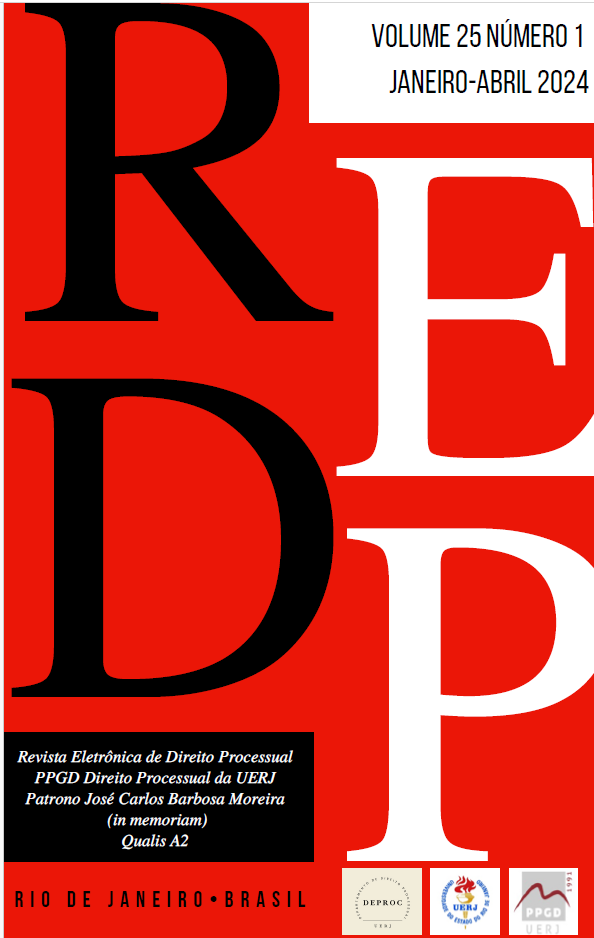DISEÑO E IMPLEMENTACIÓN DEL PROCESO MONITORIO COMO HERRAMIENTA ESENCIAL DE LOS SISTEMAS DE JUSTICIA
DOI:
https://doi.org/10.12957/redp.2024.81921Resumo
El proceso monitorio tiene por finalidad la rápida creación de un título de ejecución (llamado también “título ejecutivo” en algunos países), considerando la baja probabilidad de oposición del demandado. Para ello, se resuelve inicialmente sobre la pretensión del actor (o se intima el cumplimiento de la obligación del requerido, según los sistemas), dándose luego al demandado la oportunidad de oponerse. Si el demandado no se opone, la decisión inicial puede ejecutarse (título de ejecución). Si el demandado se opone, se abre el debate con pleno cumplimiento del derecho de defensa. La técnica monitoria, se presenta como una estructura procesal especial en la cual hace al monitorio tanto el requerimiento de cumplimiento (resolución inicial) como la eventual fase de oposición que se genere (sea que se sustancie por los trámites ordinarios o se siga una estructura sumaria). Se trata de alcanzar la máxima eficiencia y eficacia descargando de trabajo al juez en gran parte de los casos, para permitir que los asuntos que requieran mayor estructura procesal y oralidad puedan disponer de ella en el proceso ordinario. Un adecuado diseño del proceso monitorio no infringe los principios fundamentales del debido proceso. El texto trae algunas experiencias comparadas como Alemania, Ecuador, Colombia, Uruguay y Brasil. En el marco de la digitalización plena del proceso y la ayuda de la inteligencia artificial, podría concebirse un proceso monitorio incluso sin patrocinio letrado, con la solicitud diseñada como un simple formulario digital, para casos específicos donde sea baja la probabilidad de oposición del demandado (sea por el sistema de incentivos o por el alto porcentaje de fiabilidad de la pretensión del actor, dependiendo de sistemas puros o documentales). Ello, en el contexto latinoamericano de excesiva litigación permitiría contar con una herramienta eficiente, que descargaría a juezas y jueces de parte importante de su tarea, pudiendo abocarse a la dirección de las audiencias de los procesos odinarios y sumarios o a los proporcionalmente pocos casos en que se abra el debate en los procesos monitorios.
Downloads
Publicado
Como Citar
Edição
Seção
Licença
Copyright (c) 2024 Santiago Pereira Campos

Este trabalho está licenciado sob uma licença Creative Commons Attribution 4.0 International License.
Todos os artigos publicados na Revista Eletrônica de Direito Processual (REDP) (Departamento de Direito Processual, Universidade do Estado do Rio de Janeiro, Brasil) são licenciados por meio de uma Licença Creative Commons - Atribuição 4.0 Internacional (CC BY 4.0).
Os autores retêm os direitos autorais de seu artigo e concordam em licenciar seu trabalho com a licença CC BY 4.0, aceitando assim os termos e condições específicos desta licença disponíveis no seguinte website: https://creativecommons.org/licenses/by/4.0/legalcode.
- Os autores concedem à REDP o direito de primeira publicação, de se identificar como publicadora original do trabalho e concedem à revista uma licença de direitos não exclusivos para utilizar o trabalho das seguintes formas: Reproduzir, vender e distribuir cópias eletrônicas ou impressas do manuscrito como um todo, de partes específicas do manuscrito e de suas traduções para qualquer idioma;
- O uso do artigo por terceiros é livre, contanto que a integridade da publicação seja mantida e seus autores originais, periódico de primeira publicação e detalhes de citação sejam identificados.
Dentro dos termos da licença, os autores podem entrar em acordos contratuais adicionais separados para a distribuição não exclusiva da versão publicada do trabalho na revista.
Copyright and Licensing
All articles published in the Procedural Law Electronic Review (REDP) (Department of Procedural Law, State University of Rio de Janeiro, Brazil) are licensed under a Creative Commons License - Attribution 4.0 International (CC BY 4.0).
- Authors retain copyright to their article and agree to license their work under the CC BY 4.0 license, thereby accepting the specific terms and conditions of this license available at the following website: https://creativecommons.org/licenses/by/4.0/ legal code.
- Authors grant REDP the right of first publication, to identify itself as the original publisher of the work, and grant the journal a non-exclusive license to use the work in the following ways: Reproduce, sell and distribute electronic or printed copies of the manuscript as a whole, of specific parts of the manuscript and its translations into any language;
- Use of the article by third parties is free, as long as the integrity of the publication is maintained and its original authors, first publication journal, and citation details are identified.
Within the terms of the license, authors may enter into separate additional contractual agreements for the non-exclusive distribution of the published version of the work in the journal.




